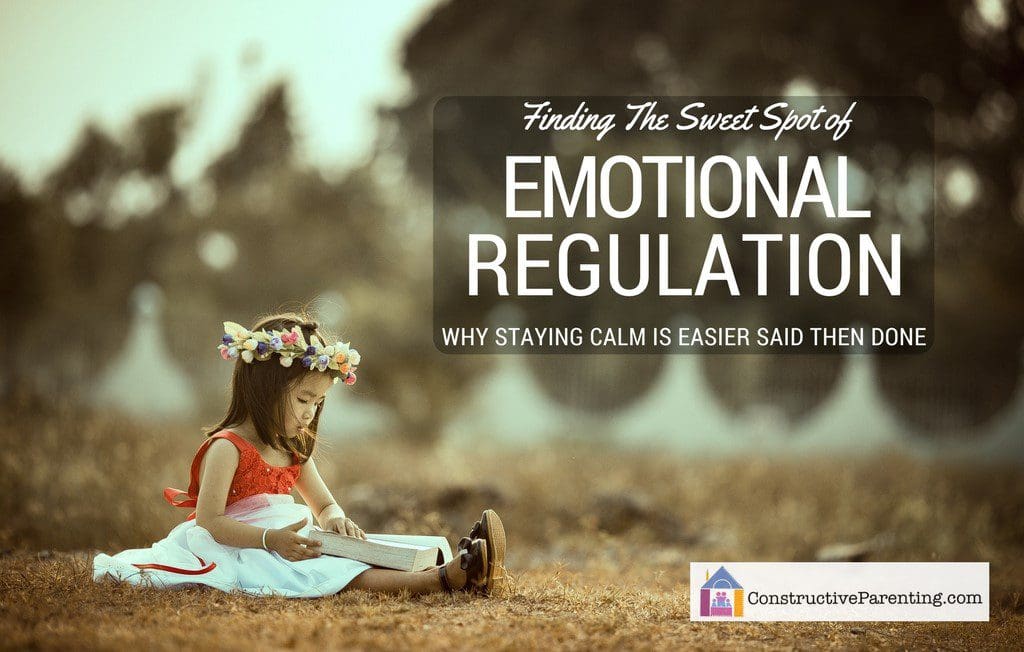Finding the Sweet Spot of Emotional Regulation: Why Staying Calm is Easier Said Than Done

My husband and I usually think of our nine-year-old as our “easy child.” She is a good listener and she rarely complains but lately at dinner time, she has been falling apart. Some nights she laughs like a crazy person and refuses to cooperate with even the simplest requests. Other times she puts her head down on the table and refuses to answer questions. As a parent, it can be so confusing to figure out why one minute our children seem perfectly capable and the next they are needy or out of control.
The key to this mystery is a term called “regulation.” When we are experiencing regulation, we are capable of being fully present and productive in the moment. We are able to get things accomplished, and when little problems pop up, we handle them and then move on. Over time we each learn self-care strategies that help us stay in the zone. For some it is making it to the gym regularly. For others it is carving out down time or grabbing coffee with friends.
But even as adults with lots of life experience we know what it means to get thrown off course and become dysregulated. Maybe we skipped a meal or maybe we’re stressed about an upcoming presentation and suddenly we enter a less productive state. You can think of regulation as the magic “sweet spot” balanced on a scale between feelings of helplessness and feelings of being completely stressed out. The unbalanced states are dysregulation.
When children experience regulation, they are capable of encountering a problem and then solving it effectively. When parents experience regulation they are able to face a stressor, such as a tantrumming child, remain calm and then think of a plan to make the situation better. The problem is that this sweet spot of regulation is relatively small and it takes practice to widen the zone.
By using functional MRIs, scientists have identified what is happening in the brain when we are regulated and when we are dysregulated. One second you are in the sweet spot going about your day. Then a frustrating situation pops up. The amygdala (a tiny almond shaped mass of gray matter in the brain) acts like a guard on a watchtower always scanning your surroundings for signs of stress or danger. When it detects something stressful it diverts most of the blood in the brain to the brain stem which kicks into survival mode. We experience this as the fight, flight, or freeze response. In this moment, our brain goes into auto-pilot and we react.
This survival strategy is perfectly adaptive when the risk detected is a hungry bear. The problem is that most of the stressors in our modern world are not actually life threatening events. Our amygdala picks up on a silly argument between siblings or a child complaining about the dinner options, and we enter dysregulation. Have you ever yelled at your child or your spouse and seconds later realized what you said and regretted it? You were in dysregulation.
Another relevant discovery in brain science is that the Prefrontal Cortex (PFC), the logical part of the brain, does not finish forming until the age of 25. Imagine being a child who is facing stress without the benefit of a fully formed PFC. In fact, it is our job as parents to act as an external PFC in order to help our children “co-regulate.” Imagine a baby who needs to burp (stressor) and starts to cry (dysregulation). Instinctively a mother scoops the baby up, makes soothing noises and starts to pat the baby on the back. The baby’s cries subside as her needs are met. The mother and child are in the sweet spot co-regulating.
What we often fail to recognize as parents is that this need for co-regulation doesn’t end as our children become verbal. When a child is in dysregulation, it takes practice for him to return to a regulated state on his own. Co-regulating serves as a shortcut, bringing a child quickly back to the sweet spot because he doesn’t have to access his logical brain while he is overwhelmed. Children quickly pick up on cues that they are safe from their parents and this allows them to return to a regulated state. A parent’s job is to serve as an external PFC for his or her children well after they have left the baby years.
When a child starts to show a pattern of behavior that is frustrating or annoying (like my daughter at dinner lately) it is a sign that she is in dysregulation. As an external PFC our job is to look for signs of what is causing stress in our children, so that we can help them return their brains to a regulated state. The following are a list of possible stressors to keep in mind.
Too Much Screen Time
Many people think of screen time as down time. It is something to do after a long and exhausting day in order to let your brain rest and reboot. Unfortunately, screen time leads to the opposite response in the brain. The amygdala is on high alert as it takes in fast moving images and loud sounds. In fact “attention engineers” have figured out exactly how to trigger your amygdala to keep you interested for the maximum amount of time. Pay attention to your children’s behavior the next time they are on a screen and just after you ask them to turn them off or put them down. You will likely see the results of over stimulation. In my house, it usually looks like arguing and bad attitude that lasts for 10-15 minutes after the screens go off.
Lack of Sleep
If you’re not sure how much sleep your child should be getting, look up the recommendations from the American Academy of Pediatrics and you may be surprised by what you find. Some children are able to function perfectly well with less sleep but if your child’s behavior has you concerned, one of the first places to start is making the amount of sleep they get each night a priority. Try making a change and increasing sleep by even 30 minutes a night for a week to see if this impacts your child’s behavior for the better.
Too Little Down Time
Consider whether over scheduling could be leading to undue stress in your child’s life. It is important to balance your child’s schedule of organized activities with much needed downtime. If they are in school for seven hours a day, and then they have karate and gymnastics to follow, their brains are not getting much time to unplug and re-regulate. Make sure your child has time for unscheduled play (think spontaneous kickball game in the cul-de-sac or creating a Lego tower in their room) and don’t be afraid to let them be bored. Remember, boredom inspires creativity in a way scheduled play cannot.
Unpredictable Schedule
Children thrive on regular schedules and predictability. In fact, young children who cannot yet understand time depend on predictable events each day for a sense of security. Predictable schedules are more important for some children than others, but if each day is different in your household, consider whether adding some consistency might help to ground your child.
If you have concerns about your child’s behavior and you are looking for support in understanding their stressors, I can help. I specialize in helping parents make concrete changes so that they can better support their children and help them thrive. If you live in NC, I would love to work with you. Email me at amandazaidman@constructiveparenting.com to schedule a free, 15-minute phone consultation.











Wow! Definitely one of the best parenting articles I have read! Helps to put in perspective my family’s routine and how it may affect our 6 year old.
This is great! Thank you-I often talk with parents of the kiddos I see for therapy about Emotional Regulation. I love the fact that you mentioned downtime. It is SO important, especially when it comes to the more anxious kiddos who so desperately need to slow down. Looking forward to using this as a resource/reading material for the parents I work with.
Great article. Thank you!
This article is very informative. I have read and gain a lot of information about this one and I do hope that others would also read this.